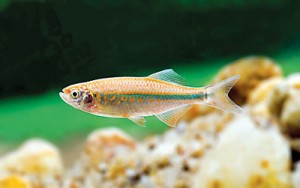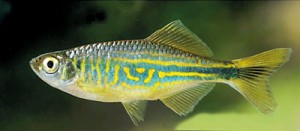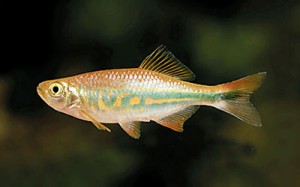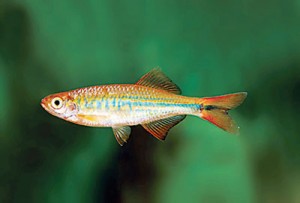News
Four new species of Devario discovered in Sri Lanka
It is a ‘fishy’ tale, much to do with stripes, both vertical and horizontal, leading to two species expanding to six.

From left are researchers Sudesh Batuwita, Madura De Silva and Sampath Udugampala who have been pursuing the Devario trail
Peering at slow-flowing streams, followed up by morpho-metric analysis, the threesome of Sudesh Batuwita, Madura De Silva and Sampath Udugampala of the Wildlife Conservation Society, Galle (WCSG), have discovered that Sri Lanka is home to four new species of Devario, rather than just two. Of these six species, five are endemic to the country. Morpho-metric analysis is a quantitative analysis of form, encompassing size and shape.
Identifying these freshwater fish by their distinct colour patterns and other morphological characters, the four new point-endemic (found only at a particular spot) species have been described thus:
Devario micronema which has a limited distribution in well-shaded, shallow, slow-flowing streams in the Kitulgala area, the Kelani river basin and the borders of the Kelani Valley Forest Reserve. With a higher body depth, it has 3 to 5 irregular vertical bars on the anterior half of the body; broader yellowish ‘middle (P) stripe’ in the posterior part and a prominent square-shaped process on its first infra-orbital ring. This species was first described in 1863 by Pieter Bleeker giving the type locality as ‘Ceylon’ and was known as a scientifically invalid species.
Devario monticola which is confined to Agra oya, a tributary of the upper reaches of the Mahaweli river in the central hills, is an endemic fish which is being recorded from the highest elevation in Sri Lanka. It can be distinguished by 4 to 5 dark, irregular, vertical bars restricted to the anterior half of the body, while the ‘lower (P-1) stripe’ is narrower than the ‘middle (P) stripe’.
Devario udenii is found in the upper reaches of the Gin river basin, in the Homadola stream in Udugama and has been named after Prof. Udeni Edirisinghe of the University of Peradeniya for his immense service to ichthyology and animal science. This fish can be distinguished by 5 to 6 dark, irregular, broad, vertical bars anterior to the level of the dorsal-fin origin and a ‘lower (P-1) stripe’ equal in width to the ‘middle (P) stripe’.
Devario annnataliae is also found in the upper reaches of the Gin river basin, but is restricted to the torrents close to the foot of the Brahmana Ella waterfall in the Sinharaja World Heritage Site. It has been named after the late wildlife enthusiast, Natalie Ann Ratnawira (February 14, 1990-June 23, 2012) for her contribution to the welfare and conservation of wild animals since her childhood. Its distinctive marks are the lower body depth, the pale yellow body and the 5 to 6 irregular and dark blue vertical bars on the anterior-half of the body.
The research has been published in the 2017 volume of the scientific journal, ‘Fish Taxa’.

Devario monticola
Before the latest discoveries, Sri Lanka boasted of the endemic D. pathirana with a very limited distribution at a few points of the Nilwala river basin and the native D. malabaricus with a wider distribution throughout the country. D. pathirana has been categorized as ‘Critically Endangered’ in the 2012 Red List, while D. malabaricus falls under the ‘Least Concern’ category.
The existence of another species, the endemic D. aequipinnatus, meanwhile, has not been clear and the taxonomic status doubtful. It was thought to be restricted to the Knuckles mountain range and categorized as ‘Critically Endangered’ but with the latest research and publication of this paper, the record of D. aequipinnatus has become invalid.
The WCSG contribution to conservation of Sri Lanka’s biodiversity through research and publication of data has been invaluable since the early 1990s, it is learnt.
Currently reading for his Ph.D in China’s Nanjing Forestry University, Sudesh is a young scientist who has contributed his knowledge on the taxonomy of lizards, amphibians and freshwater fish. WCSG President Madura De Silva has conducted many studies on ecology, taxonomy and a range of aspects, while being the Co-author of the book, ‘Sri Lankan Freshwater Fishes’. Sampath, meanwhile, an emerging scientist and member of the WCSG has much passion for the study of freshwater fish.

Devario udenii
As Sri Lanka is known as a biodiversity hotspot, it bears high species richness and high endemism, according to the researchers. Among the country’s fauna, freshwater fish are known as highly diverse taxa. Though they hav attracted the attention of scientists for centuries, there is much more to be discovered.
The study team explains that in the past decade, this taxonomic group has been revised several times, introducing a dozen species new to science within a short time period. Now the checklist of Sri Lankan freshwater fishes contains about 90 species including 53 endemics.
The fish trail goes back to 2007, when the WCSG, in collaboration with the Biodiversity Secretariat, launched the Islandwide Freshwater Fish Survey with financial aid from the Nations Trust Bank. In this eight-year survey, supported by all its members as well as the Department of Wildlife Conservation, the Forest Department, the National Museum and many others, the WCSG discovered several new species, while also re-recording some species which were thought to be extinct and re-validating some scientifically invalid species.
| Endemic Devario: Extinction concerns | |
| While there is excitement over the discovery of four more species of Devario in Sri Lanka, there are major concerns about the threats of extinction faced by all endemic species of this freshwater fish.The urgent need is for immediate conservation measures.Explaining that the habitats of endemic Devario have been highly degraded due to anthropogenic (human) activity including mini-hydro power plants, agro-chemical use and unmanaged tourism, the researchers stress that these freshwater fish could suffer a tragic fate, if urgent measures are not taken to conserve them. Devario species generally prefer pristine aquatic habitats and cannot tolerate rapid environmental changes, the researchers point out, explaining that D. pathirana is highly threatened by habitat degradation and already categorized as ‘Critically Endangered’ and even though the newly described Devario species are yet to be assessed with regard to their conservation status, it is clear that all of them are under threat. Taking up each species, the researchers reiterate that D. micronema is restricted to Kitulgala, where several development projects including mini and mega-hydro power plants are proposed, while the area is also very popular for tourism which can cause an impact on the ecosystem. D. monticola is restricted to a small area of the Agra oya where there has been total deforestation for tea cultivations since the 19th century. The agro-chemicals used in nearby tea estates could be a severe threat to it. The researchers lament that D. udenii and D. annnataliae are restricted to two separate locations in the upper reaches of the Gin river basin, where several development projects such as the Dellawa mini-hydro power plant have been proposed. This will have a major impact on the survival of both species. This is while the habitat of D. udenii is close to oil-palm cultivations, which pose another threat to them. |

Devario micronema

Devario annnataliae

